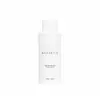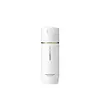What's inside
What's inside
 Key Ingredients
Key Ingredients

No key ingredients
 Benefits
Benefits

 Concerns
Concerns

No concerns
 Ingredients Side-by-side
Ingredients Side-by-side

Mannitol
HumectantSodium Cocoyl Glycinate
CleansingSodium Lauroyl Glutamate
Zeolite
AbsorbentSilica
AbrasiveBetaine
HumectantAllantoin
Skin ConditioningPotassium Laurate
EmulsifyingPolycaprolactone
StabilisingParfum
MaskingZea Mays Starch
AbsorbentPEG-75
HumectantDipotassium Glycyrrhizate
HumectantDisodium EDTA
Trehalose
HumectantWater
Skin ConditioningButylene Glycol
HumectantPapain
Skin ConditioningLactobacillus Ferment Lysate
Skin ConditioningCI 19140
Cosmetic ColorantZingiber Officinale Root Extract
MaskingZiziphus Jujuba Fruit Extract
Skin ConditioningCamellia Sinensis Leaf Extract
AntimicrobialMannitol, Sodium Cocoyl Glycinate, Sodium Lauroyl Glutamate, Zeolite, Silica, Betaine, Allantoin, Potassium Laurate, Polycaprolactone, Parfum, Zea Mays Starch, PEG-75, Dipotassium Glycyrrhizate, Disodium EDTA, Trehalose, Water, Butylene Glycol, Papain, Lactobacillus Ferment Lysate, CI 19140, Zingiber Officinale Root Extract, Ziziphus Jujuba Fruit Extract, Camellia Sinensis Leaf Extract
Ingredients Explained
These ingredients are found in both products.
Ingredients higher up in an ingredient list are typically present in a larger amount.
Betaine is a common humectant (a substance that promotes retention of moisture). It's known to be gentle on the skin and can help balance hydration.
This ingredient is best for improving hydration and soothing irritated skin. Studies also show it helps even out skin tone.
Fun fact: Betaine is naturally created in the skin and body. The kind found within cosmetic products can be either plant-derived or synthetic.
Another name for betaine is trimethylglycine.
Learn more about BetaineMannitol is a sugar alcohol. It is a humectant and moisturizes the skin. In vitro (not tested on a living organism), mannitol displays antioxidant properties.
When found in aqueous solutions, mannitol tends to become acidic. This is because it loses a hydrogen ion. This is why mannitol can often be found with pH adjusting ingredients, such as sodium bicarbonate.
Fun fact: Mannitol can be found in foods as a sweetener. It can be naturally found in mushrooms, algae, fruits, and veggies.
Learn more about MannitolSodium Lauroyl Glutamate is the sodium salt from the lauric acid of glutamic acid.
It is a surfactant and helps cleanse the skin. Surfactants gather oil, dirt, and other pollutants from your skin so they may be washed away easily.
Trehalose is a disaccharide made of two glucose molecules (glucose is sugar!). Trehalose is used to help moisturize skin. It also has antioxidant properties.
As a humectant, trehalose helps draw moisture from the air to your skin. This helps keep your skin hydrated.
Due to its antioxidant properties, trehalose may help with signs of aging. Antioxidants help fight free-radical molecules, unstable molecules that may damage your skin.
In medicine, trehalose and hyaluronic acid are used to help treat dry eyes.
Some animals, plants, and bacteria create trehalose as a source of energy to survive freeze or lack of water.
Learn more about TrehaloseZea Mays Starch is starch made from corn. You might know this as cornstarch . It is used to thicken a product. It can replace talc as an absorbent.
The pH of cornstarch is 5.92.
Cornstarch is a common food ingredient used to thicken soups or to make corn syrup.
Learn more about Zea Mays Starch